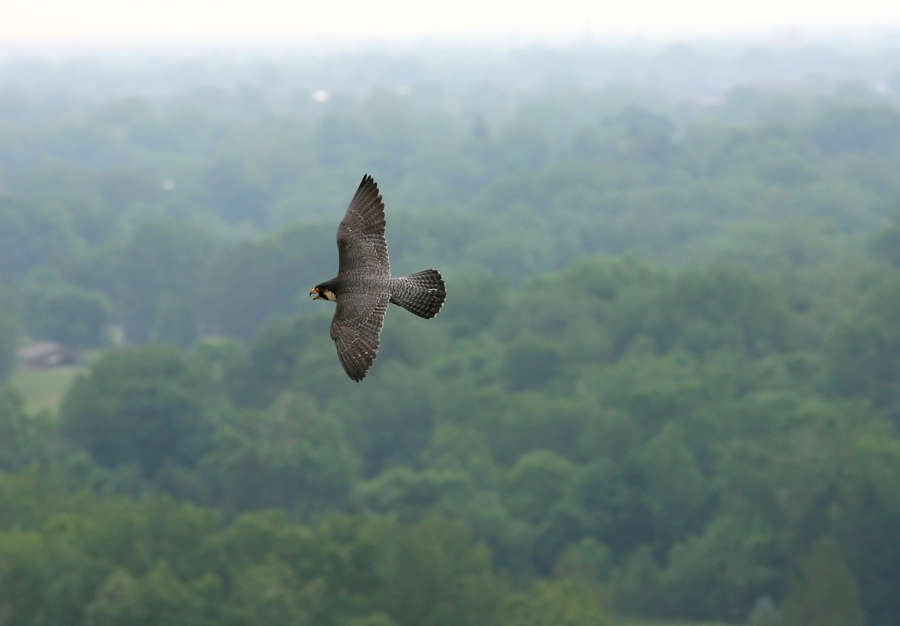History

Photograph by Daniel Miller
Master of the skies
Powerful and fast-flying, the Peregrine Falcon hunts medium-sized birds, dropping
down on them from high above in a spectacular stoop. The speed of a peregrine has
been said to reach 175 miles per hour or more. Experiments conducted by scientists
put the bird’s diving speed at approximately 200 miles per hour and level flight at
approximately 62 miles per hour.
Once virtually eradicated from eastern North America by pesticide poisoning in the
middle 20th century, peregrine falcons have benefited from recovery efforts and made
an incredible rebound. They’re now regularly seen in many large cities and coastal
areas.
Placed on the federal endangered species list in 1970, the American peregrine falcon
has been successfully introduced into many eastern U.S. states, but Ohio’s first nesting
pair wasn’t identified until 1988 at a downtown Toledo site. Since the birds in the
wild prefer high rocky ledges to build their nests, tall buildings make an ideal urban
habitation for them. Statewide, well over two dozen breeding pairs are recorded.
The species’ rebound has made it one of the conservation movement’s success stories
and it was removed from the endangered species list in 1999, although it is still
a legally protected bird.
UToledo’s Peregrines
Only homegrown falcons get the UToledo welcome mat rolled out for them! The other
variety, headquartered at BGSU down the road, knows well enough not to tempt Rocket
Power!
The two adult peregrines who have made UToledo their home were first observed frequenting
the University Hall Tower in the late winter of 2006. Photographs and a visit from
the Ohio Division of Wildlife seemed to confirm that the two were a mated pair, so
in March 2007, a team from Wildlife District Two Office installed a nesting ledge
for the birds. The peregrines accepted it and started a nest that resulted in three
eggs, which hatched that May.
Leg bands identified the adult male as Allen, hatched in Lima in 2004, and the adult
female as a 2003 hatchling of the University of Pittsburgh Cathedral of Learning (which
resembles the University Hall Tower!). Since birds banded in Pennsylvania are not
given names, UToledo has bestowed an honorary name on her: Belle, as she raised her
brood in the University Hall (Bell) Tower.
As of spring 2013, this pair has successfully raised 20 offspring, all of whom have
left the nest to establish territories and nests of their own. Although first-year
mortality is high for young peregrines, at least one of Belle and Allen’s brood has
established a nest: Chayton, who was hatched at UToledo in 2007, mated with a female
named Big Red and they’ve successfully raised two broods atop a municipal building
in Jackson, MI.
Sadly, Belle did not return to the nest for the start of the 2015 breeding season. In April 2014, at the age of 11, she had successfully fought off an attempt by another female to take over the nest, and at least one naturalist thought that she may have already had some vulnerability that younger birds would try to exploit. In 2015, Allen mated with a new female, unofficially named Liadan (Gaelic for grey lady), who does not have a leg band to identify her age or hatch site.
Liadan’s inexperience as a first-time mother was ameliorated by Allen, who could be seen taking the lead with the hatchlings. Liadan learned quickly and their first brood successfully fledged in June 2015. The following year, Rocky was her new mate, hailing from Lima, OH. Their first brood — a large one at six — fledged in 2016, and the following year the same adults raised a brood of five, four of whom were observed to fledge.
In 2019, Rocky was still the resident male, but a new female — unofficially named Astra — was with him. A young unbanded peregrine, she was initially skittish about the nest box, but grew comfortable enough to lay six eggs. Her first experience of mothering the chicks profited from Rocky’s know-how, and all five of their hatchlings (three males, two females) successfully fledged.
Family guys and girls
This year’s chicks will be learning to fly in the spring. Gradually they’ll have become
masters of at least their territory’s air; keep a sharp eye upward and you may be
rewarded with the sight of the young birds’ acrobatic flights as they interact with
their parents, each other and the occasional angry robins who sometimes harass the
new flyers — at least until the peregrines learn to hunt for themselves. The process
of going airborne has its risks, so if you happen to see a young peregrine on the
ground, call UToledo Grounds at 419.530.1011 so personnel can return the fledging
flier to the safety of the nest.
The adult peregrines patiently teach their fledglings (birds who have fledged, or
achieved flight) the ins and outs of obtaining their own food, and if you spend some
late-afternoon/early-evening time on Centennial Mall, you can see the dinnertime rituals
that prove what superb hunters peregrines are.
Like any child, the young peregrines prefer to let their parents feed them, and will
sit atop a perch on a UToledo building and “cry” for a snack.
By late September, however, the adult peregrines will have taught their brood the
skills to survive; nature will do the rest, and the young birds will be drawn to migrate.
Peregrines — the word itself is derived from “wanderer” or “traveler” — migrate vast
distances, as far as Central America. If there is sufficient food available, the adult peregrines often
remain at the University for the winter.


